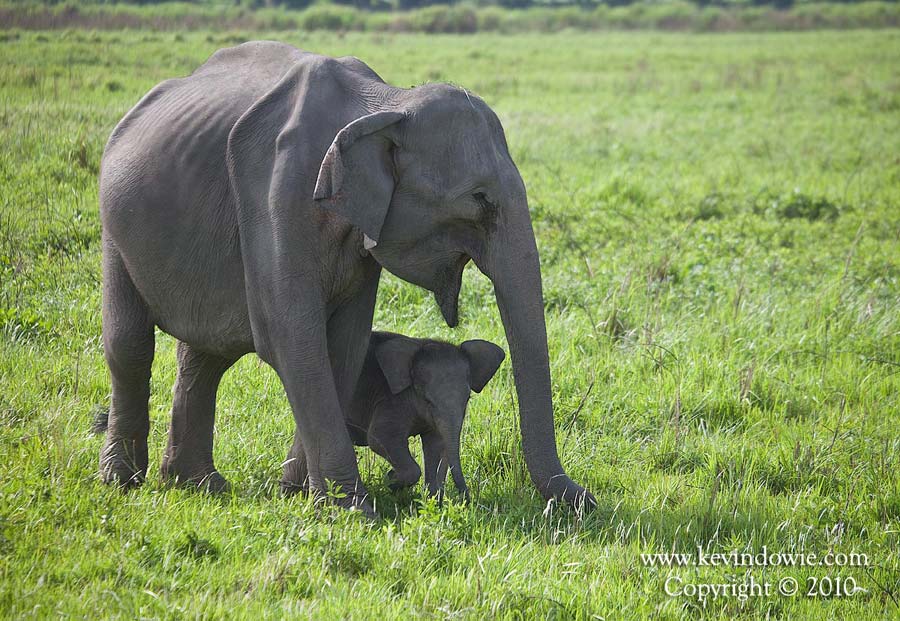Kaziranga National Park
Been a while since we’ve tested the aw-shucks value of wildlife photographs so today’s the day. Today’s image was taken in the Kaziranga National Park in India and shows Indian Elephants, a mother with her baby. The Indian Elephant, more correctly known as the Asiatic Elephant (Elephas maximus), is slightly smaller than the African Elephant and has several anatomical differences, smaller ears, arched back, different head shapes and so on. While there are still wild populations, like many animals it is threatened in the wild due to habitat loss.
Mixed-Use – National Parks in India
One of the notable things about some of the national parks in India is that whilst the borders of parks are defined, unlike national parks in other parts of the world, the human need for land use is such that some agricultural use of national park land is tolerated. The line between what is protected and not is blurred. The result was that in Assam it was not uncommon to see domesticated animals and wild species sharing the same ground.
This photograph gives a glimpse of this apparent contradiction. Although in a national park, if you look closely you can see a chain around one of the adult’s legs, it is not a truly wild animal and hence it is with some consternation that I’ve included today’s blog entry under the “wildlife photography” category.

Getting traffic to your blog.
The vagaries of Search Engine use.
To keep track of what’s happening, in terms of how many people visit and how they find my blog, I have Google analytics installed and periodically check the statistics. What’s the secret to getting traffic to your blog? Some of the recommendations when setting up a blog or website include using page titles and keywords which are appropriate to your content in the hope that people searching Google, or other search engines, will find your page. It’s interesting, surprising and at times just plain bewildering to see the results. To show just how strange, inappropriate or illogical some of this can be, I’ll share with you some of the notable issues that jump out from the google stats for this blog.
Each month my blog is being accessed via over 100 search terms (the words or terms that people type into search engines), some of these words/terms provide dozens of hits each month, whilst some only provide 1 or 2 hits per month. You can get an idea of the tone and variety of keywords I use by looking at the foot of each blog entry.
Over the last month (and this has been consistent over the last several months) the most successful keyword for the blog is: “Lion”. This one keyword is responsible for roughly 45% of all search engine traffic to my blog site. Extraordinary! But it gets better (stranger?), there are numerous variations on the “Lion” search theme. Lion photos, lion images, pictures of lions, photos of lions, lion walking through grass, etc, etc, etc. When totalled up, the “Lion” keywords, with all their variations, account for roughly 65% of all search engine traffic to my blog. How can it be that there is such an amazing skewing of results?
Here’s the next point to this. If my blog was solely about, or specializing in, “lions”, then this might well be expected, and appropriate. However, consider this, I’ve now posted about 100 blog entries with appropriate keywording on all entries. Of the 100 entries, only one entry related to “Lions”, that entry consisted of a single photograph and about 2 sentences of text! “Well”, you might say, “perhaps more people are interested in and searching for ‘lions’ rather than say ‘bird photography’ or ‘telephoto lens’ or something else you’ve written about on the blog”. Maybe, but 65% of all search engine traffic for one blog entry among 100 entries?
Are there other possible explanations? Lots of people link to my “Lions” blog entry and direct other visitors to it? Well no, I can check that as well, (sadly) my blog gets very few backlinks, none to the “Lions” entry as far as I can see. I’ve been inconsistent with my blogging techniques? No, I’m fairly predictable.
It should be pointed out that the keywords I use and the search terms or words that people type into Google, Bing, Yahoo and so on, sometimes don’t match at all. I’m pretty sure I never used keywords like; “category of endangerment golden langur monkey” or “www.total male nude photo Indian naga sadhu” but people have searched for those terms and traffic has come to the blog via such searches.
I remember blogging a couple of years ago about my earliest experience with using a search engine when a search for “Microsoft” took me to “www.I’ve got a big #%*&!.com”, mind-boggling how such a connection was ever made. It appears that search engine technology and methods have come a long way since those days and at least my blog hasn’t been mistaken for a pornography site.
Obviously, the internet is constantly evolving and search engine providers have to deal with the attempts by unsavoury characters to manipulate things for their own ends. But I think it’s fair to say that despite all the considerable efforts by Google and others, there’s still a long way to go before search engines are truly reliable in matching internet users with appropriate content.
(PS: Yes I know there are other factors to consider regarding search engine optimization (SEO), captioning of photographs, alt tags, submission of site maps, etc.)
~ KD.
